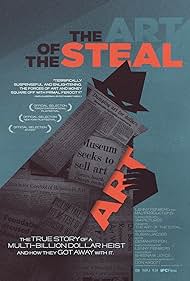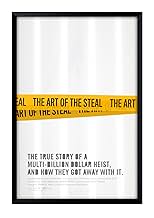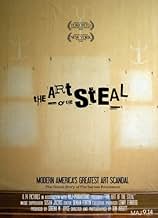IMDb RATING
7.5/10
2.5K
YOUR RATING
Documentary that follows the struggle for control of Dr. Albert C. Barnes' 25 billion dollar collection of modern and post-impressionist art.Documentary that follows the struggle for control of Dr. Albert C. Barnes' 25 billion dollar collection of modern and post-impressionist art.Documentary that follows the struggle for control of Dr. Albert C. Barnes' 25 billion dollar collection of modern and post-impressionist art.
- Awards
- 1 nomination
Photos
Richard Feigen
- Self - World-Renowned Art Dealer
- (as Richard L. Feigen)
John F. Street
- Self - Mayor of Philadelphia
- (as John Street)
Robert Zaller
- Self - Professor of History & Politics, Drexel University
- (as Dr. Robert Zaller)
Storyline
Did you know
- SoundtracksIron Man
Written by Ozzy Osbourne (as John Osbourne), Tony Iommi, Geezer Butler and Bill Ward
Performed by The Bad Plus
Courtesy of Sony
Featured review
This well-made documentary is informative and fascinating, but I don't think it fairly presents the arguments for those who disagree with its thesis, which is that Barnes' will should be meticulously respected as it pertains to his amazing art collection.
Those who feel otherwise are portrays as gangsters, thieves, Philistines: power-hungry jerks with selfish motives. While there is an undoubtedly an element of truth to those accusations, it is not the entire story. I feel I must play a little devil's advocate for a more charitable spin on 'the other side.'
It appears to me that the collection's arrangement and display in the original Barnes building is hopelessly outdated: crammed together in the style of a century ago, and arranged according to the whim of one man who is long dead. The modern museum gives art much more space to breathe, and scholars and curators can and do illuminate art by arranging it, and juxtaposing it, in new and different ways.
Why should these works be arranged, forever, in only one pattern, and in only one building? Blockbuster exhibitions are not merely money-makers for museums, but are opportunities to see art in a different context, and for scholars and curators to advance the study of art by combining pieces in new and different ways.
Why, logically, should cultural treasures be considered the property of one man legacy for all of eternity? I can see the logic of requesting an owner's wishes for a long period of time--say, for 50 years. But for centuries? Owners of art deserve respect, but the notion that ownership can extend out into an infinite future is crazy. Just as copyrighted works eventually enter the public domain, so should artworks become available for the benefit and enjoyment of the larger public.
Barnes' name should be, and will be, associated with this art for a very long time. But his obsessions and whims and taste should not dictate the fate of his collection for all time. Allowing the work to travel, and to be arranged differently, and to even move into a new building, is reasonable (over centuries, a dozen different curators and scholars might bring their era's thinking and aesthetic to the collection).
I concede that this might be painful for Lower Merion, and to those who agree with Barnes' will. But Barnes has been dead for decades. Ownership and control of objects of major cultural importance should, eventually, pass from the control of an owner who has long been dead.
And Matisse's line, about how the Barnes was the only sane place in America to view art, should be taken with a grain of salt: if he saw the best art museums in America today, he may very well have changed his mind. A world-class museum today is far, far superior to any art museum of a century ago. Each generation produces new scholarship, and artworks of genuine cultural importance should be available to the finest scholars and curators of each generation. To do otherwise is to overvalue the taste and importance of a single individual who died decades ago, and to undervalue the art's importance to the wider world.
Those who feel otherwise are portrays as gangsters, thieves, Philistines: power-hungry jerks with selfish motives. While there is an undoubtedly an element of truth to those accusations, it is not the entire story. I feel I must play a little devil's advocate for a more charitable spin on 'the other side.'
It appears to me that the collection's arrangement and display in the original Barnes building is hopelessly outdated: crammed together in the style of a century ago, and arranged according to the whim of one man who is long dead. The modern museum gives art much more space to breathe, and scholars and curators can and do illuminate art by arranging it, and juxtaposing it, in new and different ways.
Why should these works be arranged, forever, in only one pattern, and in only one building? Blockbuster exhibitions are not merely money-makers for museums, but are opportunities to see art in a different context, and for scholars and curators to advance the study of art by combining pieces in new and different ways.
Why, logically, should cultural treasures be considered the property of one man legacy for all of eternity? I can see the logic of requesting an owner's wishes for a long period of time--say, for 50 years. But for centuries? Owners of art deserve respect, but the notion that ownership can extend out into an infinite future is crazy. Just as copyrighted works eventually enter the public domain, so should artworks become available for the benefit and enjoyment of the larger public.
Barnes' name should be, and will be, associated with this art for a very long time. But his obsessions and whims and taste should not dictate the fate of his collection for all time. Allowing the work to travel, and to be arranged differently, and to even move into a new building, is reasonable (over centuries, a dozen different curators and scholars might bring their era's thinking and aesthetic to the collection).
I concede that this might be painful for Lower Merion, and to those who agree with Barnes' will. But Barnes has been dead for decades. Ownership and control of objects of major cultural importance should, eventually, pass from the control of an owner who has long been dead.
And Matisse's line, about how the Barnes was the only sane place in America to view art, should be taken with a grain of salt: if he saw the best art museums in America today, he may very well have changed his mind. A world-class museum today is far, far superior to any art museum of a century ago. Each generation produces new scholarship, and artworks of genuine cultural importance should be available to the finest scholars and curators of each generation. To do otherwise is to overvalue the taste and importance of a single individual who died decades ago, and to undervalue the art's importance to the wider world.
- How long is The Art of the Steal?Powered by Alexa
Details
Box office
- Gross US & Canada
- $544,890
- Opening weekend US & Canada
- $39,019
- Feb 28, 2010
- Gross worldwide
- $544,890
- Runtime1 hour 41 minutes
- Color
Contribute to this page
Suggest an edit or add missing content







